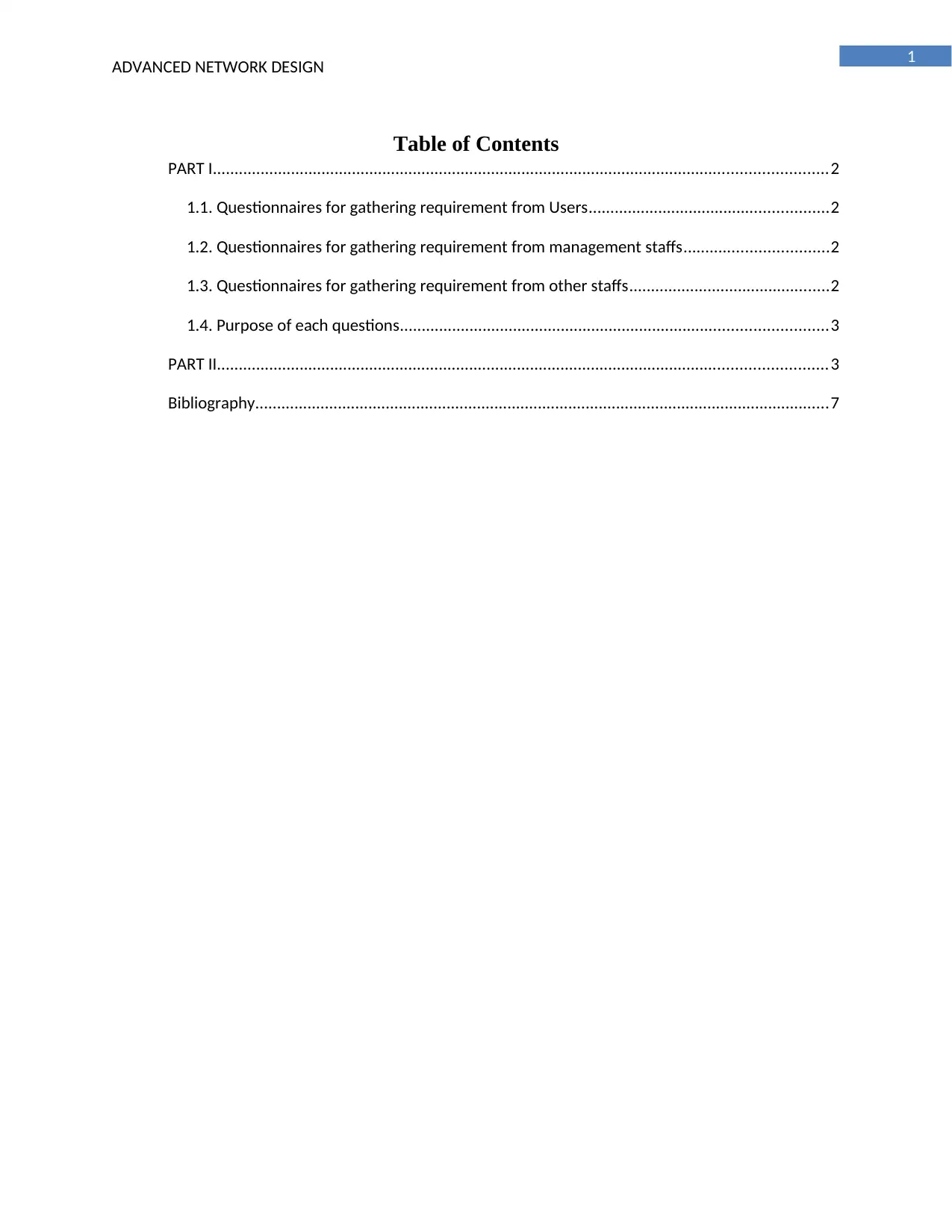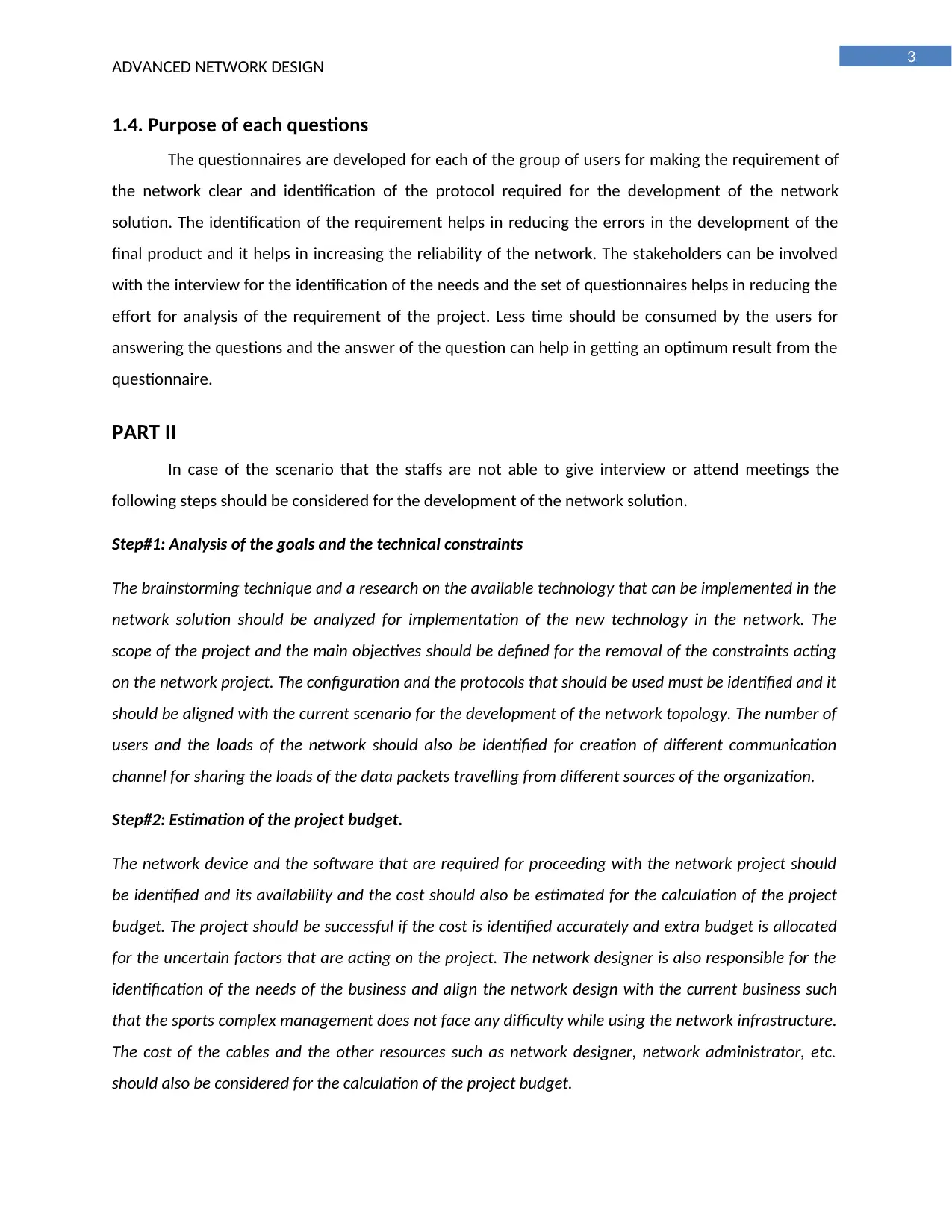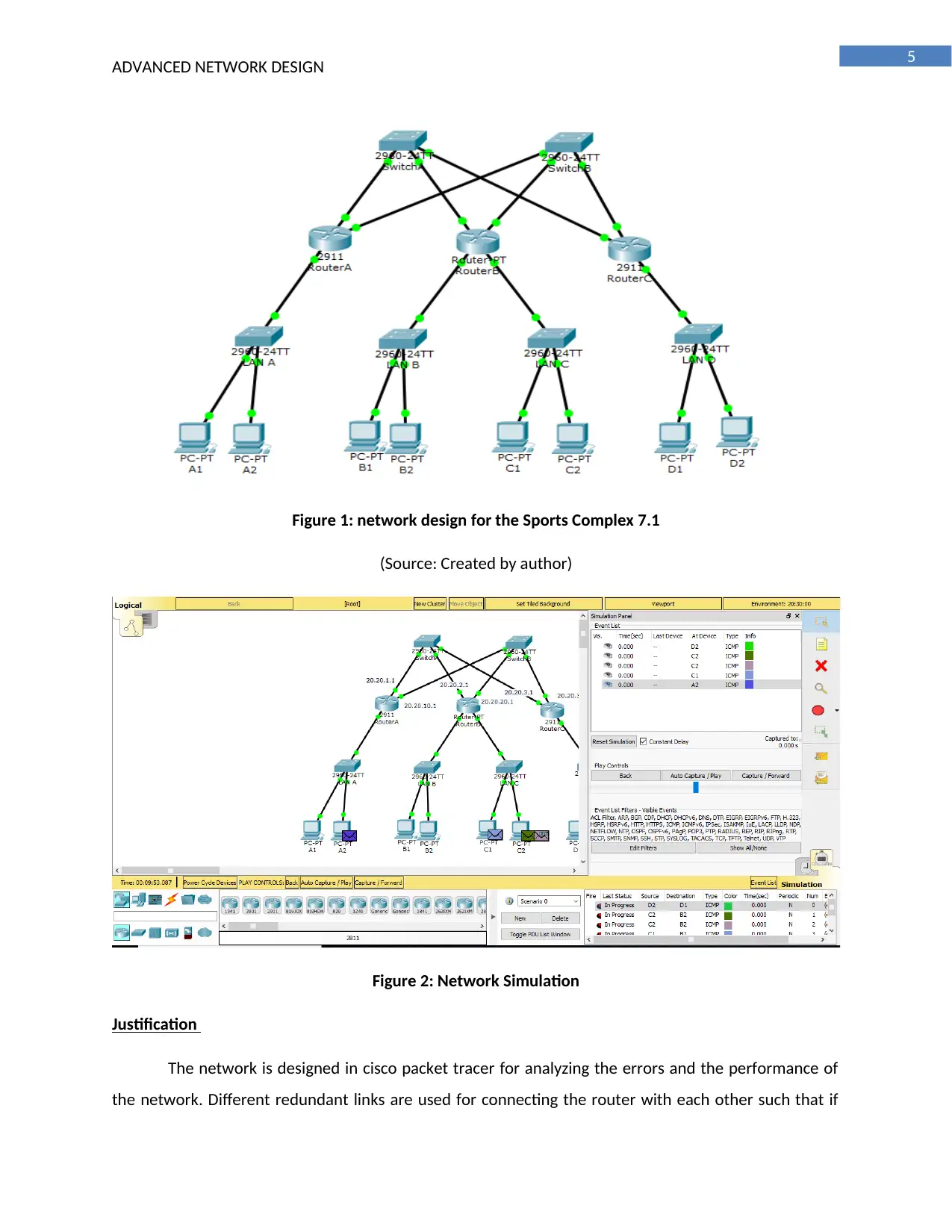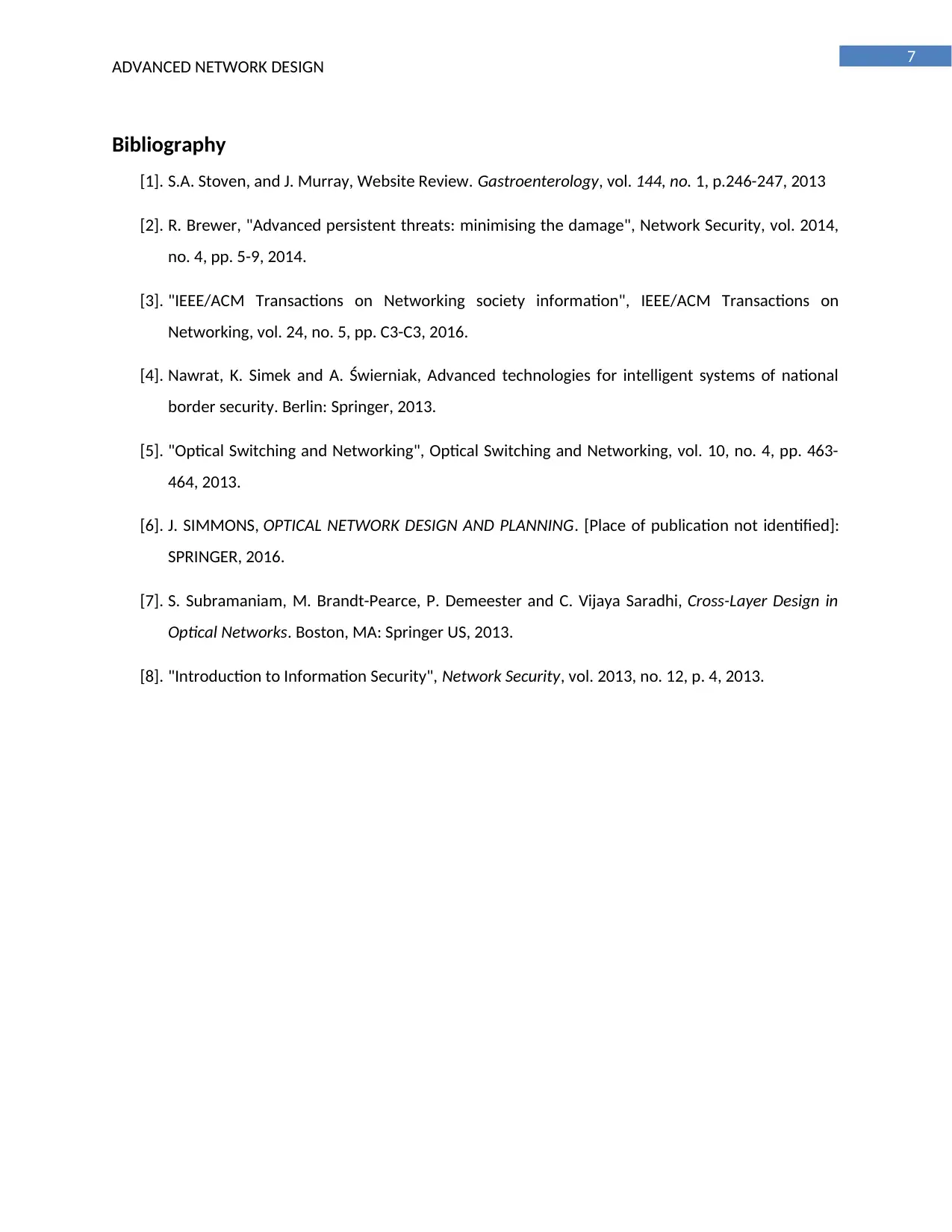MN621 Advanced Network Design: Human Factors & Performance Metrics
VerifiedAdded on 2023/06/12
|8
|1528
|341
Report
AI Summary
This report provides an analysis of advanced network design, focusing on human factors and performance metrics as outlined in the MN621 Advanced Network Design course. It includes questionnaires designed to gather requirements from users, management, and other staff, detailing the purpose of each question in clarifying network needs and protocols. The report also addresses alternative strategies for gathering requirements when interviews are not feasible, including analyzing goals, estimating project budgets, creating application profiles, defining service level agreements (SLAs), setting performance standards, and monitoring service levels. A network design for a sports complex is presented, along with a justification for the network simulation, highlighting the use of redundant links and pre-deployment testing to ensure reliability. Desklib offers a wealth of resources, including similar solved assignments and past papers, to aid students in their studies.

Running head: ADVANCED NETWORK DESIGN
Advanced Network Design
Name of the Student
Name of the University
Author’s Note
Advanced Network Design
Name of the Student
Name of the University
Author’s Note
Paraphrase This Document
Need a fresh take? Get an instant paraphrase of this document with our AI Paraphraser

1
ADVANCED NETWORK DESIGN
Table of Contents
PART I.............................................................................................................................................2
1.1. Questionnaires for gathering requirement from Users.......................................................2
1.2. Questionnaires for gathering requirement from management staffs.................................2
1.3. Questionnaires for gathering requirement from other staffs..............................................2
1.4. Purpose of each questions..................................................................................................3
PART II............................................................................................................................................3
Bibliography....................................................................................................................................7
ADVANCED NETWORK DESIGN
Table of Contents
PART I.............................................................................................................................................2
1.1. Questionnaires for gathering requirement from Users.......................................................2
1.2. Questionnaires for gathering requirement from management staffs.................................2
1.3. Questionnaires for gathering requirement from other staffs..............................................2
1.4. Purpose of each questions..................................................................................................3
PART II............................................................................................................................................3
Bibliography....................................................................................................................................7

2
ADVANCED NETWORK DESIGN
PART I
1.1. Questionnaires for gathering requirement from Users
What are the applications that should be installed in the workstations?
How many group off users are using the network?
What type of device are used for connecting with the network and enabling
communication between the clients connected in the network?
What are the constraints faced during using the current network system?
What are the applications and the websites frequently used in the workplace?
1.2. Questionnaires for gathering requirement from management staffs
What are the expected number of users having the access of the current network
infrastructure?
How many floors are there in the building that are needed to be covered by the
network?
How many servers should be used for management of the current activity of the users
connected with the network?
What is the cost allocated for the development of the network solution for the sports
complex?
Which group of users should be given the access of the servers installed in the network?
Is there any scope of future expansion of the network for the accommodation of the
growth of the network?
1.3. Questionnaires for gathering requirement from other staffs
What are the main uses of the network for the management of the information?
What types of websites and applications are accessed or installed in the workstation and
used for the management of the system?
How many application requires internet connectivity for its working?
Which staffs are required to be connected with the network for its working?
What types of files are shared and stored in the local server for increasing the flexibility
of the system.
ADVANCED NETWORK DESIGN
PART I
1.1. Questionnaires for gathering requirement from Users
What are the applications that should be installed in the workstations?
How many group off users are using the network?
What type of device are used for connecting with the network and enabling
communication between the clients connected in the network?
What are the constraints faced during using the current network system?
What are the applications and the websites frequently used in the workplace?
1.2. Questionnaires for gathering requirement from management staffs
What are the expected number of users having the access of the current network
infrastructure?
How many floors are there in the building that are needed to be covered by the
network?
How many servers should be used for management of the current activity of the users
connected with the network?
What is the cost allocated for the development of the network solution for the sports
complex?
Which group of users should be given the access of the servers installed in the network?
Is there any scope of future expansion of the network for the accommodation of the
growth of the network?
1.3. Questionnaires for gathering requirement from other staffs
What are the main uses of the network for the management of the information?
What types of websites and applications are accessed or installed in the workstation and
used for the management of the system?
How many application requires internet connectivity for its working?
Which staffs are required to be connected with the network for its working?
What types of files are shared and stored in the local server for increasing the flexibility
of the system.
⊘ This is a preview!⊘
Do you want full access?
Subscribe today to unlock all pages.

Trusted by 1+ million students worldwide

3
ADVANCED NETWORK DESIGN
1.4. Purpose of each questions
The questionnaires are developed for each of the group of users for making the requirement of
the network clear and identification of the protocol required for the development of the network
solution. The identification of the requirement helps in reducing the errors in the development of the
final product and it helps in increasing the reliability of the network. The stakeholders can be involved
with the interview for the identification of the needs and the set of questionnaires helps in reducing the
effort for analysis of the requirement of the project. Less time should be consumed by the users for
answering the questions and the answer of the question can help in getting an optimum result from the
questionnaire.
PART II
In case of the scenario that the staffs are not able to give interview or attend meetings the
following steps should be considered for the development of the network solution.
Step#1: Analysis of the goals and the technical constraints
The brainstorming technique and a research on the available technology that can be implemented in the
network solution should be analyzed for implementation of the new technology in the network. The
scope of the project and the main objectives should be defined for the removal of the constraints acting
on the network project. The configuration and the protocols that should be used must be identified and it
should be aligned with the current scenario for the development of the network topology. The number of
users and the loads of the network should also be identified for creation of different communication
channel for sharing the loads of the data packets travelling from different sources of the organization.
Step#2: Estimation of the project budget.
The network device and the software that are required for proceeding with the network project should
be identified and its availability and the cost should also be estimated for the calculation of the project
budget. The project should be successful if the cost is identified accurately and extra budget is allocated
for the uncertain factors that are acting on the project. The network designer is also responsible for the
identification of the needs of the business and align the network design with the current business such
that the sports complex management does not face any difficulty while using the network infrastructure.
The cost of the cables and the other resources such as network designer, network administrator, etc.
should also be considered for the calculation of the project budget.
ADVANCED NETWORK DESIGN
1.4. Purpose of each questions
The questionnaires are developed for each of the group of users for making the requirement of
the network clear and identification of the protocol required for the development of the network
solution. The identification of the requirement helps in reducing the errors in the development of the
final product and it helps in increasing the reliability of the network. The stakeholders can be involved
with the interview for the identification of the needs and the set of questionnaires helps in reducing the
effort for analysis of the requirement of the project. Less time should be consumed by the users for
answering the questions and the answer of the question can help in getting an optimum result from the
questionnaire.
PART II
In case of the scenario that the staffs are not able to give interview or attend meetings the
following steps should be considered for the development of the network solution.
Step#1: Analysis of the goals and the technical constraints
The brainstorming technique and a research on the available technology that can be implemented in the
network solution should be analyzed for implementation of the new technology in the network. The
scope of the project and the main objectives should be defined for the removal of the constraints acting
on the network project. The configuration and the protocols that should be used must be identified and it
should be aligned with the current scenario for the development of the network topology. The number of
users and the loads of the network should also be identified for creation of different communication
channel for sharing the loads of the data packets travelling from different sources of the organization.
Step#2: Estimation of the project budget.
The network device and the software that are required for proceeding with the network project should
be identified and its availability and the cost should also be estimated for the calculation of the project
budget. The project should be successful if the cost is identified accurately and extra budget is allocated
for the uncertain factors that are acting on the project. The network designer is also responsible for the
identification of the needs of the business and align the network design with the current business such
that the sports complex management does not face any difficulty while using the network infrastructure.
The cost of the cables and the other resources such as network designer, network administrator, etc.
should also be considered for the calculation of the project budget.
Paraphrase This Document
Need a fresh take? Get an instant paraphrase of this document with our AI Paraphraser

4
ADVANCED NETWORK DESIGN
Step#3: Application profile creation and related with the network application
The network service that should run on the network for running the sports complex management system
should be defined and documented for the configuration of the network according to the needs. The
network administrator should be able to troubleshoot the network for identification of the configuration
and problem faced for the configuration of the network device. The number of user using the
information system should be identified and grouped according to the user policy for the creation for the
application profile.
Step#4: SLA creation including the availability, response, fault tolerance, threshold, upgradation
The different factors affecting the performance of the network should be included in the service level
agreement and it should be maintained such that the network is never down and maintained for getting
the best output from the network. The network downtime should be minimum and no data should not be
lost while sending from different sources of the network.
Step#5: Standards of performance and availability
The constraints such as loss of data packets, congestion, packet jittering should be eliminated such that
the network device are available and the errors in the project should be removed. The routers should be
configured with quality of service such that the network performs best all the time and it does not have a
negative impact of the users connected with the network.
Step#6: Service level definition monitoring and metric collection
The service level definition is collected and the performance and throughput issues are gathered for
meeting the objectives of the network. The monitoring of the data traffic in the network helps in
identification of the root issues and the associated problem for developing the network infrastructure.
ADVANCED NETWORK DESIGN
Step#3: Application profile creation and related with the network application
The network service that should run on the network for running the sports complex management system
should be defined and documented for the configuration of the network according to the needs. The
network administrator should be able to troubleshoot the network for identification of the configuration
and problem faced for the configuration of the network device. The number of user using the
information system should be identified and grouped according to the user policy for the creation for the
application profile.
Step#4: SLA creation including the availability, response, fault tolerance, threshold, upgradation
The different factors affecting the performance of the network should be included in the service level
agreement and it should be maintained such that the network is never down and maintained for getting
the best output from the network. The network downtime should be minimum and no data should not be
lost while sending from different sources of the network.
Step#5: Standards of performance and availability
The constraints such as loss of data packets, congestion, packet jittering should be eliminated such that
the network device are available and the errors in the project should be removed. The routers should be
configured with quality of service such that the network performs best all the time and it does not have a
negative impact of the users connected with the network.
Step#6: Service level definition monitoring and metric collection
The service level definition is collected and the performance and throughput issues are gathered for
meeting the objectives of the network. The monitoring of the data traffic in the network helps in
identification of the root issues and the associated problem for developing the network infrastructure.

5
ADVANCED NETWORK DESIGN
Figure 1: network design for the Sports Complex 7.1
(Source: Created by author)
Figure 2: Network Simulation
Justification
The network is designed in cisco packet tracer for analyzing the errors and the performance of
the network. Different redundant links are used for connecting the router with each other such that if
ADVANCED NETWORK DESIGN
Figure 1: network design for the Sports Complex 7.1
(Source: Created by author)
Figure 2: Network Simulation
Justification
The network is designed in cisco packet tracer for analyzing the errors and the performance of
the network. Different redundant links are used for connecting the router with each other such that if
⊘ This is a preview!⊘
Do you want full access?
Subscribe today to unlock all pages.

Trusted by 1+ million students worldwide

6
ADVANCED NETWORK DESIGN
one link fails the data packet can reach the destination address following the duplicate link. The network
solution is tested before deploying in the real life for the elimination of the risk associated with the
development of the network solution. Thee router interfaces should be configured according the given
IP addressing plan and it is connected with the switch for the distribution of the network to the PC
connected with the different LAN of the network.
ADVANCED NETWORK DESIGN
one link fails the data packet can reach the destination address following the duplicate link. The network
solution is tested before deploying in the real life for the elimination of the risk associated with the
development of the network solution. Thee router interfaces should be configured according the given
IP addressing plan and it is connected with the switch for the distribution of the network to the PC
connected with the different LAN of the network.
Paraphrase This Document
Need a fresh take? Get an instant paraphrase of this document with our AI Paraphraser

7
ADVANCED NETWORK DESIGN
Bibliography
[1]. S.A. Stoven, and J. Murray, Website Review. Gastroenterology, vol. 144, no. 1, p.246-247, 2013
[2]. R. Brewer, "Advanced persistent threats: minimising the damage", Network Security, vol. 2014,
no. 4, pp. 5-9, 2014.
[3]. "IEEE/ACM Transactions on Networking society information", IEEE/ACM Transactions on
Networking, vol. 24, no. 5, pp. C3-C3, 2016.
[4]. Nawrat, K. Simek and A. Ś wierniak, Advanced technologies for intelligent systems of national
border security. Berlin: Springer, 2013.
[5]. "Optical Switching and Networking", Optical Switching and Networking, vol. 10, no. 4, pp. 463-
464, 2013.
[6]. J. SIMMONS, OPTICAL NETWORK DESIGN AND PLANNING. [Place of publication not identified]:
SPRINGER, 2016.
[7]. S. Subramaniam, M. Brandt-Pearce, P. Demeester and C. Vijaya Saradhi, Cross-Layer Design in
Optical Networks. Boston, MA: Springer US, 2013.
[8]. "Introduction to Information Security", Network Security, vol. 2013, no. 12, p. 4, 2013.
ADVANCED NETWORK DESIGN
Bibliography
[1]. S.A. Stoven, and J. Murray, Website Review. Gastroenterology, vol. 144, no. 1, p.246-247, 2013
[2]. R. Brewer, "Advanced persistent threats: minimising the damage", Network Security, vol. 2014,
no. 4, pp. 5-9, 2014.
[3]. "IEEE/ACM Transactions on Networking society information", IEEE/ACM Transactions on
Networking, vol. 24, no. 5, pp. C3-C3, 2016.
[4]. Nawrat, K. Simek and A. Ś wierniak, Advanced technologies for intelligent systems of national
border security. Berlin: Springer, 2013.
[5]. "Optical Switching and Networking", Optical Switching and Networking, vol. 10, no. 4, pp. 463-
464, 2013.
[6]. J. SIMMONS, OPTICAL NETWORK DESIGN AND PLANNING. [Place of publication not identified]:
SPRINGER, 2016.
[7]. S. Subramaniam, M. Brandt-Pearce, P. Demeester and C. Vijaya Saradhi, Cross-Layer Design in
Optical Networks. Boston, MA: Springer US, 2013.
[8]. "Introduction to Information Security", Network Security, vol. 2013, no. 12, p. 4, 2013.
1 out of 8
Related Documents
Your All-in-One AI-Powered Toolkit for Academic Success.
+13062052269
info@desklib.com
Available 24*7 on WhatsApp / Email
![[object Object]](/_next/static/media/star-bottom.7253800d.svg)
Unlock your academic potential
Copyright © 2020–2025 A2Z Services. All Rights Reserved. Developed and managed by ZUCOL.



